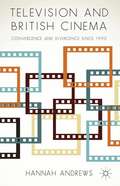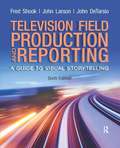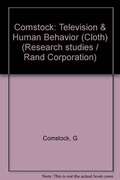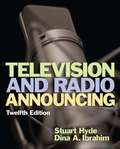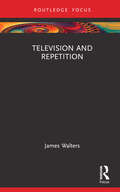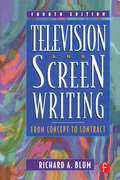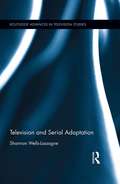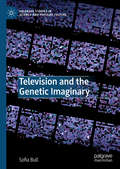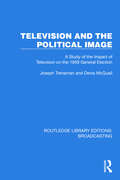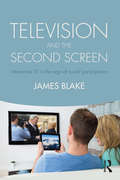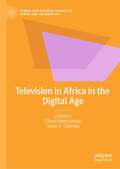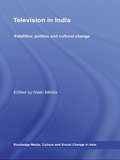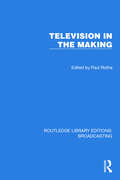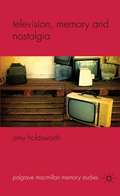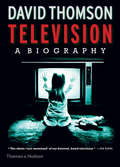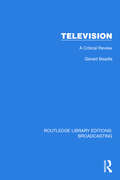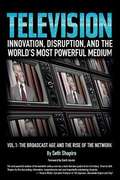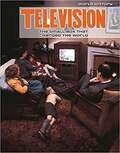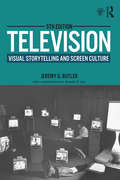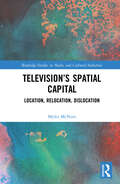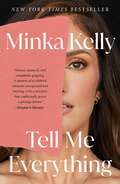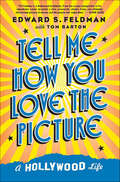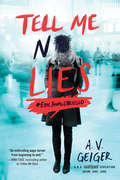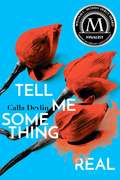- Table View
- List View
Television and British Cinema
by Hannah AndrewsUndertaking a thorough and timely investigation of the relationship between television and cinema in Britain since 1990, Hannah Andrews explores the convergence between the two forms, at industrial, cultural and intermedial levels, and the ways in which the media have also been distinguished from one another through discourse and presentation.
Television and Field Reporting (Sixth Edition)
by Fred Shook John Larson John DetarsioUpdated in its 6th edition, Television Field Production and Reporting provides an exciting introduction to the art of visual storytelling. Endorsed by the National Press Photographers Association, it focuses on the many techniques and tools available in television today.
Television and Human Behavior
by George Comstock Steven Chaffee Nathan KatzmanStudies the impact of television on viewers' habits, activities, and attitudes, examining patterns of viewing, concepts that television imposes on public consciousness, and effects on children, blacks, and the poor
Television and Radio Announcing, Twelfth Edition
by Stuart Hyde Dina A. IbrahimThe digital revolution has significantly changed broadcast technology. The 12th edition of Television and Radio Announcing reflects new trends in the field, such as the reconfiguration of electronic media production practices and distribution models. The internet and social media have opened up new access to production and new methods of distribution, such as YouTube, Facebook, Twitter, and podcasts. The 12th edition addresses the realities of students who live in this new era.
Television and Repetition
by James WaltersResisting some of the negative connotations that repetition can attract, this book illustrates how it has been used as a catalyst for creative expression across a range of television genres. Divided into two parts, the first three chapters contextualise repetition within related media and critical debates, before locating it as an important facet of television that is worth exploring in detail. The final three chapters discuss specific television shows that incorporate repetition creatively within their narrative structure and aesthetic composition, ranging from The Royle Family and Doctor Who to I May Destroy You and This is Going to Hurt. In each case, James Walters argues that repetition emerges as crucial to the expression of key themes and ideas, thus becoming a structural and compositional element itself. Exploring the ways in which repetition has featured in the work of figures such as Umberto Eco, Raymond Bellour and Bruce Kawin, and has influenced the approaches of television scholars like Raymond Williams, Roger Silverstone and John Ellis, this book is essential reading for scholars and students of film, television and media studies.
Television and Screen Writing: From Concept to Contract
by Richard A BlumNow in its fourth edition, Television and Screen Writing: From Concept to Contract is a classic resource for students and professionals in screenwriting and television writing. This book will teach you how to become a creative and marketable writer in every professional arena - including major studios, production companies, networks, cable and pay TV, animation, and interactive programs. Specific techniques and script samples for writing high-quality and producible "spec" scripts for theatrical motion pictures, the sitcom series, one-hour dramatic series, longform television, soaps, talk show, variety, animation, interactive and new media are provided. Television and Screen Writing: From Concept to Contract, Fourth Edition also offers a fully detailed examination of the current marketplace, and distinct strategies for marketing your scripts, from registering and copyrighting the script to signing with an agent. This new edition has been expanded to include the most up-to-date creative and professional script samples, marketing resources, and practical information possible. The companion website (www.focalpress.com/companions) offers a wide range of contacts and resources for you to explore, and Internet links to professional resources. There is also an Annotated and Selected Bibliography for your reference
Television and Serial Adaptation (Routledge Advances in Television Studies)
by Shannon Wells-LassagneAs American television continues to garner considerable esteem, rivalling the seventh art in its "cinematic" aesthetics and the complexity of its narratives, one aspect of its development has been relatively unexamined. While film has long acknowledged its tendency to adapt, an ability that contributed to its status as narrative art (capable of translating canonical texts onto the screen), television adaptations have seemingly been relegated to the miniseries or classic serial. From remakes and reboots to transmedia storytelling, loose adaptations or adaptations which last but a single episode, the recycling of pre-existing narrative is a practice that is just as common in television as in film, and this text seeks to rectify that oversight, examining series from M*A*S*H to Game of Thrones, Pride and Prejudice to Castle.
Television and the Genetic Imaginary (Palgrave Studies in Science and Popular Culture)
by Sofia BullThis book examines the complex ways in which television articulates ideas about DNA in the early 21st century. Considering television’s distinct aesthetic and narrative forms, as well as its specific cultural roles, it identifies TV as a key site for the genetic imaginary. The book addresses the key themes of complexity and kinship, which function as nodes around which older essentialist notions about the human genome clash with newly emergent post-genomic sensibilities. Analysing a wide range of US and UK programmes, from science documentaries, science fiction serials and crime procedurals, to family history programmes, sitcoms and reality shows, Television and the Genetic Imaginary illustrates the extent to which molecular frameworks of understanding now permeate popular culture.
Television and the Political Image: A Study of the Impact of Television on the 1959 General Election (Routledge Library Editions: Broadcasting #36)
by Denis McQuail Joseph TrenamanWas the 1959 UK General Election the first television election? Could television be used to create a Party ‘image’? Television and the Political Image (1961) provides answers to both these questions. It surveys two constituencies, interviewing the same cross-section of electors before and after the election campaign, and analyses and compares the campaigns as conducted by television, radio, the Press, and through the work of the local Parties. Various effects of the political barrage are measured and attributed to their sources; such effects include changes in voting intention during the course of the election campaign, changes in attitudes to Parties and their leaders, and changes in what the voter knows of the parties’ policies.
Television and the Second Screen: Interactive TV in the age of social participation
by James BlakeTelevision is changing almost beyond recognition. In the battle for consumers, social media sites, smart phones and tablets have become rivals to traditional linear TV. However, audiences and producers are also embracing mobile platforms to enhance TV viewing itself. This book examines the emerging phenomenon of the second screen: where users are increasingly engaging with content on two screens concurrently. The practice is transforming television into an interactive, participatory and social experience. James Blake examines interactive television from three crucial angles: audience motivation and agency, advances in TV production and the monetisation of second screen content. He also tracks its evolution by bringing together interviews with more than 25 television industry professionals - across the major UK channels - including commissioning editors, digital directors, producers and advertising executives. These reveal the successes and failures of recent experiments and the innovations in second screen projects. As the second screen becomes second nature for viewers and producers, the risks and opportunities for the future of television are slowly beginning to emerge. Television and the Second Screen will offer students and scholars of television theory, industry professionals and anyone with an abiding interest in television and technology, an accessible and illuminating guide to this important cultural shift.
Television in Africa in the Digital Age (Gender and Cultural Studies in Africa and the Diaspora)
by Gilbert Motsaathebe Sarah H. ChiumbuThis book places television in Africa in the digital context. It address the onslaught of multimedia platforms, digital migration and implication of this technology for society. The discussions in the chapters contained in this book encompass a wide range of issues such as digital disruption of television news, internet television and video on demand platforms, adaptations, digital migration, business strategies and management approaches, PBS, consumption patterns, scheduling and programming, evangelical television, and many others. The book is an important reading for academics, students and television practitioners. It offers an insightful view of television in Africa.
Television in India: Satellites, Politics and Cultural Change (Media, Culture and Social Change in Asia)
by Nalin MehtaThis book examines the development of television in India since the early 1990s, and its implications for Indian society more widely. Until 1991, India possessed only a single state-owned television channel, but since then there has been a rapid expansion in independent satellite channels which came as a complete break from the statist control of the past. This book explores this transformation, explaining how television, a medium that developed in the industrial West, was adapted to suit Indian conditions, and in turn has altered Indian social practices, making possible new ways of imagining identities, conducting politics and engaging with the state. In particular, satellite television initially came to India as the representative of global capitalism but it was appropriated by Indian entrepreneurs and producers who Indianized it. Considering the full gamut of Indian television - from "national" networks in English and Hindi to the state of regional language networks – this book elucidates the transformative impact of television on a range of important social practices, including politics and democracy, sport and identity formation, cinema and popular culture. Overall, it shows how the story of television in India is also the story of India's encounter with the forces of globalisation.
Television in Turkey: Local Production, Transnational Expansion and Political Aspirations
by Yeşim Kaptan Ece AlganThis edited collection takes a timely and comprehensive approach to understanding Turkey’s television, which has become a global growth industry in the last decade, by reconsidering its geopolitics within both national and transnational contexts. The Turkish television industry along with audiences and content are contextualised within the socio-cultural and historical developments of global neoliberalism, transnational flows, the rise of authoritarianism, nationalism, and Islamism. Moving away from Anglo-American perspectives, the book analyzes both local and global processes of television production and consumption while taking into consideration the dynamics distinctive to Turkey, such as ethnic and gender identity politics, media policies and regulations, and rising nationalistic sentiments.
Television in the Making (Routledge Library Editions: Broadcasting #37)
by Paul RothaTelevision in the Making (1956) looks at television in its infancy, with essays by the leaders of the medium at the time, people who were forging new paths as they imagined and actioned the possibilities of television.
Television, Memory and Nostalgia
by Amy HoldsworthAn innovative and original new study, Television, Memory and Nostalgia re-imagines the relationship between the medium and its forms of memory and remembrance through a series of case studies of British and North American programmes and practices. These include ER , Grey's Anatomy , The Wire , Who Do You Think You Are? , and Life on Mars .
Television: A Biography
by David Thomson“The invention, or the quaint piece of furniture, wandered into our lives in the 1940s, as a primitive plaything, a clever if awkward addition to the household. It was expensive, unreliable and a bit of an invalid.” —Television, A Biography In just a few years, what used to be an immobile piece of living room furniture, which one had to sit in front of at appointed times in order to watch sponsored programming on a finite number of channels, morphed into a glowing cloud of screens with access to a near-endless supply of content available when and how viewers want it. With this phenomenon now a common cultural theme, a writer of David Thomson’s stature delivering a critical history, or “biography” of the six-decade television era, will be a significant event which could not be more timely. With Television, the critic and film historian who wrote what Sight and Sound's readers called “the most important film book of the last 50 years” has finally turned his unique powers of observation to the medium that has swallowed film whole. Over twenty-two thematically organized chapters, Thomson brings his provocatively insightful and unique voice to the life of what was television. David Thomson surveying a Boschian landscape, illuminated by that singular glow—always “on”—and peopled by everyone from Donna Reed to Dennis Potter, will be the first complete history of the defining medium of our time.
Television: A Critical Review (Routledge Library Editions: Broadcasting #35)
by Gerald BeadleTelevision: A Critical Review (1963) is written by Sir Gerald Beadle, once Director of the BBC, and possessing of a long and wide experience of broadcasting as it expanded and grew. He was there at the birth of television, and details this and the subsequent developments over many years into a global phenomenon.
Television: The Broadcast Age and the Rise of the Network
by Seth ShapiroNo medium in history can match the power of television. No product has spread so far and so fast. Nothing has had so much influence. Nothing has impacted how the world sees itself like television. TELEVISION: Volume 1 brings together seven decades of stories on how this happened into one epic narrative. How did an impoverished immigrant become the king of all media, creating the first radio network and the first TV network? What caused the inventor of FM radio to jump out of a window to his death? How did NBC, CBS and ABC innovate to build their media monopolies? How did Star Trek create the first fan culture movement? What made The Mary Tyler Moore Show the first great feminist show, and #1 hit? What made Norman Lear the most influential TV comedy producer ever? How did Lucille Ball go from a washed-up B movie actress to a multi-millionaire Hollywood studio mogul? What makes Louis C. K. the Jackie Gleason of the digital age? With unparalleled insider insight, it shares critical, practical, behind the scenes lessons from the business of TV. The TELEVISION series is a must-read for media executives, students, entrepreneurs, and fans. Two-time Emmy(R) Award winner, author Seth Shapiro is a leading advisor in business innovation, media and technology. He is an Adjunct Professor at the USC School of Cinematic Arts, a Governor of the Television Academy, and Principal of New Amsterdam Media LLC.
Television: The Small Box that Changed the World (World History)
by Katie KawaIt is sometimes said that we are living in a Golden Age of television. What does that mean, and how did we get there? Readers find the answers as they trace the history of television, from its invention to the current age of Peak TV. <p><p> This fascinating story is presented to readers through informative main text, annotated quotations, detailed sidebars, primary sources, and a comprehensive timeline. Television has changed nearly every aspect of life in many countries, and readers are sure to be excited by this fun and fact-filled look at how history and television have influenced each other.
Television: Visual Storytelling and Screen Culture (Routledge Communication Ser.)
by Jeremy G. ButlerFor over two decades, Television has served as the foremost guide to television studies, offering readers an in-depth understanding of how television programs and commercials are made and how they function as producers of meaning. Author Jeremy G. Butler shows the ways in which camera style, lighting, set design, editing, and sound combine to produce meanings that viewers take away from their television experience. Highlights of the fifth edition include: An entirely new chapter by Amanda D. Lotz on television in the contemporary digital media environment. Discussions integrated throughout on the latest developments in screen culture during the on-demand era—including the impact of binge-watching and the proliferation of screens (smartphones, tablets, computer monitors, etc.). Updates on the effects of new digital technologies on TV style.
Television’s Spatial Capital: Location, Relocation, Dislocation (Routledge Studies in Media and Cultural Industries)
by Myles McNuttThis book launches a comprehensive detailing of the dramatic expansion of the geography of television production into new cities, states, provinces, and countries, and how those responsible for shaping the "landscape" of television have been forced to adapt, taking established strategies for engaging with space and place through mediated representation and renegotiating them to account for the new map of television production. Modeling media studies research that considers the intersection of production, textuality, distribution, and reception, Myles McNutt identifies how the expansion of where television is produced has intersected with the kinds of places represented on television, and how shifts in the production, distribution, and consumption of television content have shifted the burden of representing cities and countries both locally and internationally. Through a combination of industry interviews, textual analysis, and in-depth consideration of industry and audience discourse, the book argues that where television takes place matters more today than it ever has, but that the current system of spatial capital remains constrained by traditional industry logics that limit the depth of engagement with place identity even as the expectation of authenticity grows significantly. Representing a cross section of media industry studies, television studies, and cultural geography, this book will appeal to scholars and students within multiple areas of media studies, including production studies and audience studies, in addition to television studies broadly.
Tell Me Everything: A Memoir
by Minka KellyNEW YORK TIMES BESTSELLERA Washington Post best celebrity memoir of 2023An Audible best celebrity memoir of 2023“A timely, urgent portrait of working-class American women.”—Gabrielle UnionIn her highly anticipated memoir Tell Me Everything, Minka Kelly shares a story as powerful as it is page-turning.Fans know her as the spoiled, rich cheerleader Lyla Garrity on Friday Night Lights or as the affluent, mysterious Samantha on the HBO megahit Euphoria. But as revealed for the first time in these pages, Minka Kelly’s life has been anything but easy.Raised by a single mother who worked as a stripper and struggled with addiction, Minka spent years waking up in strange apartments as she and her mom bounced around the country, relying on friends and relatives to take them in. At times they even lived in storage units. She reconnected with her father, Aerosmith’s Rick Dufay, and eventually made her way to Los Angeles, where she landed the role of a lifetime on Friday Night Lights.Now an established actress and philanthropist, Minka takes this next step in her career as a writer. She has poured her soul into the pages of this book, which ultimately tells a story of triumph over adversity, and how resilience and love are all we have in the end.
Tell Me How You Love the Picture: A Hollywood Life
by Edward S. Feldman Tom BartonEdward S. Feldman's legendary career began in advertising and publicity at 20th Century-Fox in the 1950s, and from there he worked his way up to executive studio positions within Seven Arts, Filmways, and Warner Brothers. Following this, he has spent the last twenty-five years as a successful, Academy Award-nominated film producer.Ed's unique story takes readers on a more than fifty-year journey through Hollywood that few can tell--and most will never forget. With tales from the set of Whatever Happened to Baby Jane? to why a well-known actor trashed Ed's office and why a major Hollywood mogul tried to turn all of Tinseltown against one of Ed's films, readers will learn what it takes to produce a film and survive the jungles of Hollywood, laughing all the way.Tell Me How You Love the Picture is a smartly written, surprising, hilarious memoir that takes us behind the scenes with wild, no-holds-barred stories about major Hollywood personalities ranging from Bette Davis to Elizabeth Taylor, Stanley Kubrick to Scott Rudin, Harrison Ford to Jim Carrey to Eddie Murphy and more. As a top studio exec and one of Hollywood's most respected producers, Feldman has seen the film business from the inside out, worked with some of the best talent in the industry, and experienced things few can imagine.An incredible Hollywood memoir from one of moviedom's renowned producers, Tell Me How You Love the Picture is full of insight and the stuff of gossip, bad behavior, and high success.
Tell Me No Lies (Follow Me Back #2)
by A. V. GeigerRealEricThorn No one knows what happened to pop icon Eric Thorn. His Twitter account? Frozen. His cell phone? Cracked and bloody, buried in the snow. Snowflake734Tessa Hart knows the truth, but she's finally left her #EricThornObsessed days behind. She has no intention of ever touching her Twitter app again. But SnapChat...That's safer, right? Agoraphobic fangirl Tessa Hart has finally left her house—only to trade one hiding place for another. But she can only stay out of sight for so long before she's forced to face the deadly consequences of the past. Back in an interrogation room, answers only lead to more questions in the pulse-pounding conclusion to the Follow Me Back duology.
Tell Me Something Real
by Calla Devlin<p>Three sisters struggle with the bonds that hold their family together as they face a darkness settling over their lives in this masterfully written debut novel. <p>There are three beautiful blond Babcock sisters: gorgeous and foul-mouthed Adrienne, observant and shy Vanessa, and the youngest and best-loved, Marie. Their mother is ill with leukemia and the girls spend a lot of time with her at a Mexican clinic across the border from their San Diego home so she can receive alternative treatments. <p>Vanessa is the middle child, a talented pianist who is trying to hold her family together despite the painful loss that they all know is inevitable. As she and her sisters navigate first loves and college dreams, they are completely unaware that an illness far more insidious than cancer poisons their home. Their world is about to shatter under the weight of an incomprehensible betrayal...</p>
